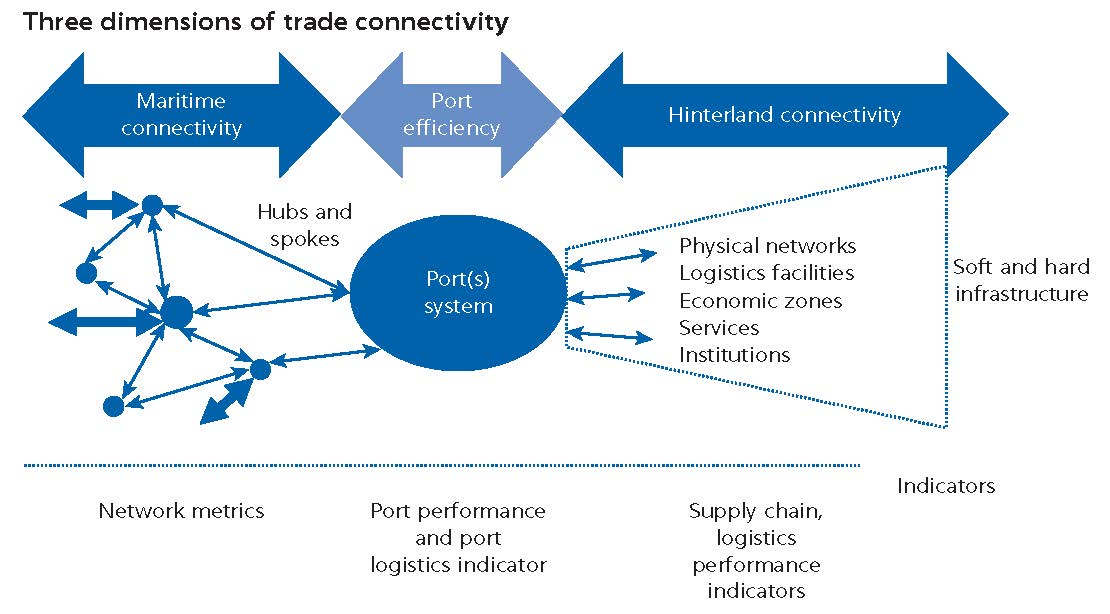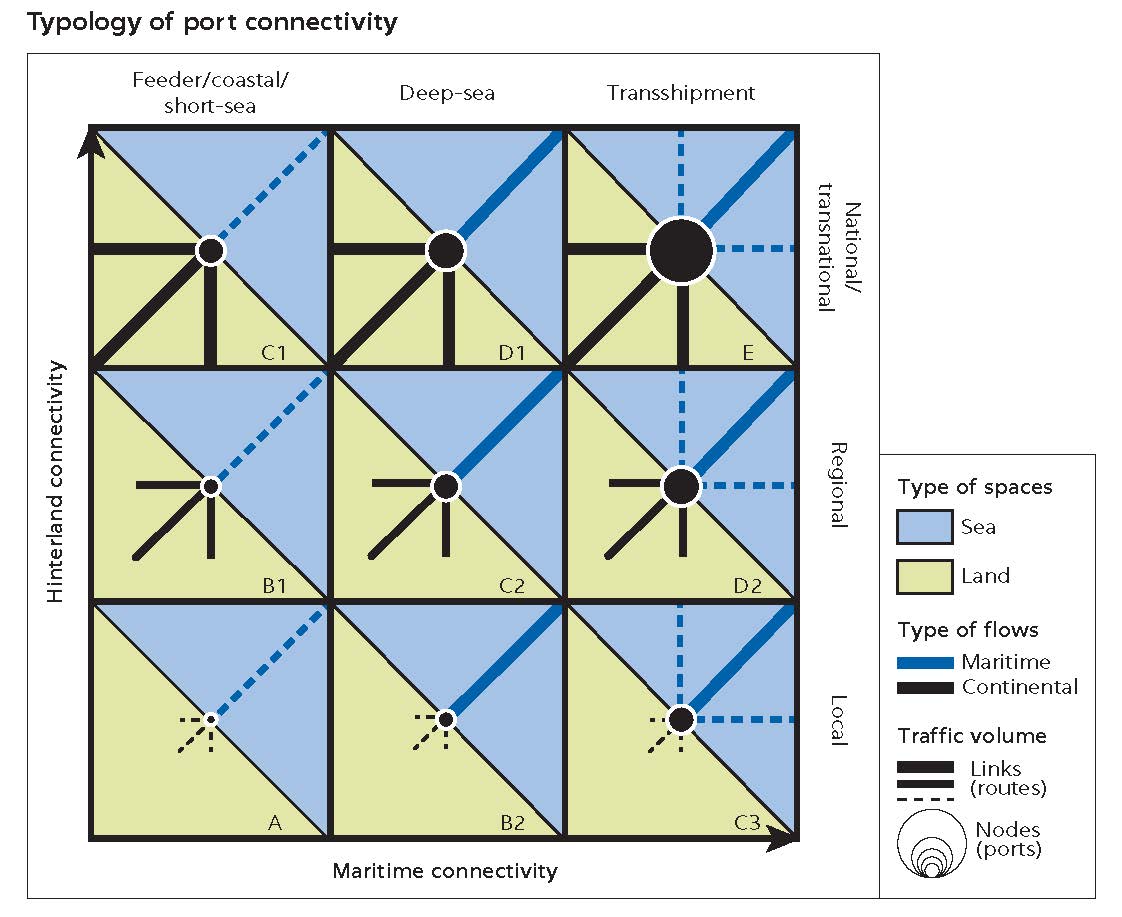Theater for millennia of one of the most fruitful areas in the world for trade and exchange, the Mediterranean, “sea between the lands”, as its etymology indicates, owes its fortune to a transport network that connects the cities facing it on the water with its own hinterland, as an area of economic and logistic influence of a port or a trade route. Even today this network of connections exists, albeit with fundamental differences from the past. It is no longer an isolated world economy: it is both a trading area and a transit area linking Europe and North Africa with the rest of the world through the hub-and-spoke structure of maritime networks, which reduces the number of transport operations, defining a barycentric hub to which the other points are connected, in a sunburst structure.
Understanding how trade connectivity works in the Mediterranean is particularly important in this historical moment in which there is an extreme need for cooperation and integration to counter the serious consequences due to political, economic and migration instability. And this is even more relevant in those developing countries in the Mediterranean, such as Morocco and Egypt, who are concerned with the economic benefits of large investments in infrastructure made on their territory.
Better connectivity is expected to increase trade with distant markets and stimulate activities in the domestic hinterland.
Three dimension of trade connectivity. (Source: “Maritime Networks, Port Efficiency, and Hinterland Connectivity in the Mediterranean” edit by Jean-François Arvis, Vincent Vesin, Robin Carruthers, César Ducruet, and Peter de Langen, World Bank Group, 2019)
The book Maritime Networks, Port Efficiency, and Hinterland Connectivity in the Mediterranean is the result of a collective work led by Jean-François Arvis and Vincent Vesin, with the collaboration of Robin Carruthers, César Ducruet and Peter de Langen. It interweaves different areas of activity of the World Bank, from macroeconomics to investments and trades on a global scale, from transport to digital development and aims to be a sort of practical analysis of the three interdependent dimensions of trade connectivity: maritime network that it concerns navigation before reaching the port, port efficiency and finally hinterland connectivity, the network of connections and players in the territory that contribute to developing the distribution chain.
Because of the complexity and richness of maritime and trade patterns in the Mediterranean, the book combines a regional focus with globally scalable lessons. Intended for a wide readership of policy makers in maritime affairs, trade, or industry; professionals from the world of finance or development institutions; and academics, the book combines empirical analysis of microeconomic shipping and port data.
In particular, it faces an integrated analysis of how maritime and hinterland connectivity create value for port users and influence the competitiveness of a port, not only from the perspective of port operators, but also from a wider range of related professions as shippers, responsible for managing economic and trade growth, operators and managers of transport and logistic networks and services.
This integration of connectivity between shipping routes and ports, on the one hand, and logistics and industrial zones, on the other, can really turn into an actual economic benefit for the territory provided that there is a holistic approach of the three dimensions in play and a model of concerted management between the multiple decision makers.
This analysis is developed through the study of three case studies: the system of the Spanish ports, taken in analysis from the point of view of the market shares of each, thanks to the availability of statistics and public data; and the study of the maritime and hinterland connectivity of the ports of Port Said, in Egypt, and of Tanger in Morocco, selected because both are primarily transshipment hubs but with the ambition, and the potential, to become a reference node for other ports. The analysis on hinterland development is articulated around five ports chosen as case studies: Barcelona, Malta, Marseille, Port Said East (Egypt) and Tanger Med.
Because of its central position in world trade, the Mediterranean therefore remains an important laboratory for a logistic model, whose integrated growth can become a fundamental instrument of peace and stability for the regions of North Africa and the Middle East.
Typology of port connectivity. (Source: “Maritime Networks, Port Efficiency, and Hinterland Connectivity in the Mediterranean” edit by Jean-François Arvis, Vincent Vesin, Robin Carruthers, César Ducruet, and Peter de Langen, World Bank Group, 2019)
This book mainly confirms the heterogeneity of the Mediterranean area, torn between North-South and East-West, as well as the lack of a unique model of port development that would be replicated from one place to another. Nevertheless, interesting similarities across time and space lead the authors to formulating important guidelines for related actors and policy-makers.
Head image: Mediterranean and other transhipment regions. (Source: “Maritime Networks, Port Efficiency, and Hinterland Connectivity in the Mediterranean” edit by Jean-François Arvis, Vincent Vesin, Robin Carruthers, César Ducruet, and Peter de Langen, World Bank Group, 2019)
Reti marittime e connettività nel Mediterraneo
Teatro per millenni di una delle aree più feconde al mondo per commerci e scambi, il Mediterraneo, “mare tra le terre”, come sta a indicare la sua etimologia, deve la sua fortuna a una rete di trasporto che mette in relazione le città affacciate sull’acqua con il proprio hinterland, inteso quale area di influenza economica e logistica di un porto o di una via commerciale. Ancora oggi questa rete di collegamenti esiste, pur con fondamentali differenze rispetto al passato. Il Mediterraneo non è più un’economia mondiale in se stessa ma è, al tempo stesso, area di commerci e luogo di transito tra Europa, Nord Africa e il resto del mondo attraverso il modello di reti logistiche marittime, Hub and Spoke, che riduce il numero di operazioni di trasporto, definendo un hub baricentrico cui sono collegati gli altri punti, in una struttura a raggera.
Comprendere quindi come funzionano i collegamenti economici e commerciali nel Mediterraneo è particolarmente importante in questo momento storico in cui c’è un estremo bisogno di cooperazione e integrazione per contrastare le gravi conseguenze dovute a instabilità politica, economica e migrazione. E questo è ancor più rilevante in quei paesi in via di sviluppo nel Mediterraneo, quali il Marocco e l’Egitto, preoccupati di ottenere ricadute economiche dai grandi investimenti in infrastrutture fatti sul loro territorio. Una migliore connettività dovrebbe comportare una crescita dei commerci con i mercati lontani e stimolare le attività nel territorio interno locale. Ma come tradurre una migliore connessione globale in un effettivo miglioramento delle opportunità economiche per persone e attività anche a livello locale?
Le tre dimensioni della connettività commerciale (Fonte: “Maritime Networks, Port Efficiency, and Hinterland Connectivity in the Mediterranean” edit by Jean-François Arvis, Vincent Vesin, Robin Carruthers, César Ducruet, and Peter de Langen, World Bank Group, 2019)
Il volume Maritime Networks, Port Efficiency, and Hinterland Connectivity in the Mediterranean è frutto di un lavoro collettivo guidato da Jean-François Arvis e Vincent Vesin, cui hanno collaborato principalmente Robin Carruthers, César Ducruet e Peter de Langen. Intreccia diversi ambiti di attività della Banca Mondiale, dalla macroeconomia agli investimenti e commerci a scala globale, dalla trasportistica allo sviluppo digitale e vuole essere una sorta di analisi pratica sui tre fattori, interconnessi tra loro, che compongono le reti commerciali: la rete marittima che riguarda la navigazione prima di raggiungere il porto, l’efficienza portuale e infine la rete dei collegamenti e dei player nel territorio che contribuiscono a sviluppare la catena distributiva. Per la complessità e la ricchezza della struttura marittima e commerciale nel Mediterraneo, il saggio elabora focus regionali con alcune considerazioni di carattere globale. Rivolto a un pubblico ampio di professionisti nel campo della finanza, dell’industria e del commercio, di accademici e politici, il libro combina l’analisi empirica di microeconomia della navigazione con i dati portuali. In particolare, viene approfondita la crescita di competitività dei porti che deriva dall’integrazione tra i collegamenti marittimi e quelli interni, nell’hinterland, non solo a livello di operatori portuali ma anche della vasta gamma di professioni ad essi connesse, dagli spedizionieri ai gestori di reti logistiche e di servizi, a chi governa la crescita dei mercati. Tale integrazione tra rotte di trasporto e porti, da un lato, e logistica e aree industriali, dall’altro, può davvero trasformarsi in effettivo beneficio economico per il territorio a condizione che ci sia un approccio olistico dei tre fattori in gioco e un modello di gestione concertata tra i diversi soggetti decisori. Tale analisi viene sviluppata attraverso lo studio di tre casi: il sistema dei porti spagnoli, presi in analisi dal punto di vista delle quote di mercato di ciascuno, grazie alla disponibilità di statistiche e dati pubblici; e lo studio delle reti di collegamento dei porti di Port Said, in Egitto, e di Tanger Med, in Marocco, scelti perché entrambi principalmente hub di transshipment ma con l’ambizione, e la potenzialità, di divenire nodo di riferimento per altri porti. L’analisi sugli sviluppi delle reti a terra verso l’hinterland si articola invece intorno a cinque porti scelti come casi studio: Barcellona, Malta, Marsiglia, Port Said East, in Egitto e Tanger Med in Marocco. Per la sua posizione centrale nei traffici mondiali, il Mediterraneo resta pertanto un importante laboratorio di un modello logistico, la cui crescita integrata può diventare uno strumento fondamentale di pace e stabilità per le regioni del Nord Africa e del Medio Oriente.
Tipologia della connettività portuale. (Fonte: “Maritime Networks, Port Efficiency, and Hinterland Connectivity in the Mediterranean” edit by Jean-François Arvis, Vincent Vesin, Robin Carruthers, César Ducruet, and Peter de Langen, World Bank Group, 2019)
Questo libro conferma principalmente l’eterogeneità dell’area mediterranea, divisa tra Nord-Sud ed Est-Ovest, e la mancanza di un modello unico di sviluppo portuale che verrebbe replicato da un luogo all’altro, tuttavia, analogie interessanti nel tempo e nello spazio hanno portato gli autori a formulare importanti linee guida per i relativi attori e responsabili politici.
Head Image: Il Mediterrano e le alter regioni di transhipment. (Fonte: “Maritime Networks, Port Efficiency, and Hinterland Connectivity in the Mediterranean” edit by Jean-François Arvis, Vincent Vesin, Robin Carruthers, César Ducruet, and Peter de Langen, World Bank Group, 2019)

